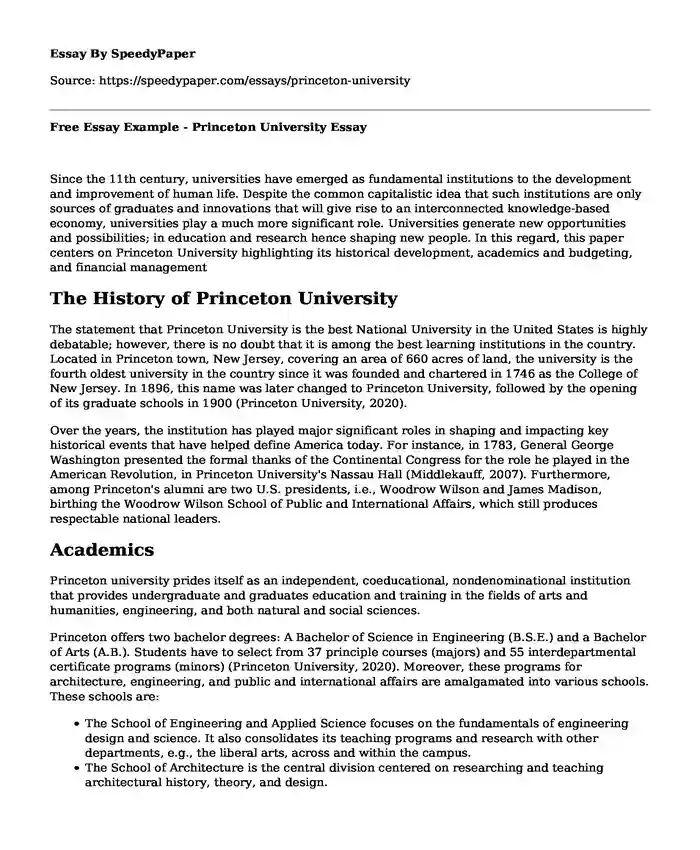
| Type of paper: | Essay |
| Categories: | University History Budgeting Financial management |
| Pages: | 3 |
| Wordcount: | 715 words |
Since the 11th century, universities have emerged as fundamental institutions to the development and improvement of human life. Despite the common capitalistic idea that such institutions are only sources of graduates and innovations that will give rise to an interconnected knowledge-based economy, universities play a much more significant role. Universities generate new opportunities and possibilities; in education and research hence shaping new people. In this regard, this paper centers on Princeton University highlighting its historical development, academics and budgeting, and financial management
The History of Princeton University
The statement that Princeton University is the best National University in the United States is highly debatable; however, there is no doubt that it is among the best learning institutions in the country. Located in Princeton town, New Jersey, covering an area of 660 acres of land, the university is the fourth oldest university in the country since it was founded and chartered in 1746 as the College of New Jersey. In 1896, this name was later changed to Princeton University, followed by the opening of its graduate schools in 1900 (Princeton University, 2020).
Over the years, the institution has played major significant roles in shaping and impacting key historical events that have helped define America today. For instance, in 1783, General George Washington presented the formal thanks of the Continental Congress for the role he played in the American Revolution, in Princeton University's Nassau Hall (Middlekauff, 2007). Furthermore, among Princeton's alumni are two U.S. presidents, i.e., Woodrow Wilson and James Madison, birthing the Woodrow Wilson School of Public and International Affairs, which still produces respectable national leaders.
Academics
Princeton university prides itself as an independent, coeducational, nondenominational institution that provides undergraduate and graduates education and training in the fields of arts and humanities, engineering, and both natural and social sciences.
Princeton offers two bachelor degrees: A Bachelor of Science in Engineering (B.S.E.) and a Bachelor of Arts (A.B.). Students have to select from 37 principle courses (majors) and 55 interdepartmental certificate programs (minors) (Princeton University, 2020). Moreover, these programs for architecture, engineering, and public and international affairs are amalgamated into various schools. These schools are:
- The School of Engineering and Applied Science focuses on the fundamentals of engineering design and science. It also consolidates its teaching programs and research with other departments, e.g., the liberal arts, across and within the campus.
- The School of Architecture is the central division centered on researching and teaching architectural history, theory, and design.
- The Woodrow Wilson School of Public and International Affairs primarily provides various multidisciplinary majors on matters related to public policy, focusing on studies and analysis of different public perspectives and generating real-world solutions to those problems.
Budgeting & Financial Management
Princeton's university budget relies heavily on all parties involved and their collective roles and responsibilities on how they utilize the institution's resources. The process of budgeting and planning is aimed to adequately and sufficiently utilize donor resources to make the best use of education and research programs. This process involves a partnership between departmental financial managers and Provost's Office and staff from the Office of Planning, Budget, and Analysis to generate reliable, deliberate financial plans.
According to Princeton's financial records, the current operational budget is over $2 billion per year, a number that highlights not only the magnitude of its annual activities but also the various plans to attain its mission (Princeton University, 2020). Given its importance and weight, the operational budget is split into different major organizational groups, i.e., the Academic Departments and Programs which is allocated 50% of the budget, the Administrative and Student Services Departments that Report Directly to the President, Provost, or Executive Vice President which is allocated 33%, the Central Financial Aid Departments allotted 10% and Princeton Plasma Physics Laboratory which reflects 7% (Princeton University, 2020).
Reference
Middlekauff, R. (2007). The Glorious Cause: The American Revolution, 1763-1789. Oxford University Press. https://books.google.co.ke/books?hl=en&lr=&id=nya0ODz-B-cC&oi=fnd&pg=PT9&dq=General+George+Washington+was+presented+the+formal+thanks+of+the+Continental+Congress+for+the+role+he+played+in+the+American+Revolution,&ots=Y1TN9AUXNL&sig=veNUUmPo2V0QBi2icmoBvk2BCLA&redir_esc=y#v=onepage&q&f=false
Princeton University. (2020). Academics. https://admission.princeton.edu/academicsPrinceton University. (2020). Budgeting & Financial Management. https://finance.princeton.edu/budgeting-financial-management
Cite this page
Free Essay Example - Princeton University. (2023, Oct 09). Retrieved from https://speedypaper.com/essays/princeton-university
Request Removal
If you are the original author of this essay and no longer wish to have it published on the SpeedyPaper website, please click below to request its removal:
- Education Essay Example: Benefits of School Uniforms
- Abolitionist Movement - American History Essay Example
- Pyramids of Giza
- Is University Education General Education or Elite Education? Paper Example
- Essay Sample on Ptarmigan Ridges School: for the Third Grade
- Essay Sample on Organizational-Wide Operating Budget for Walter Reed Psychological Center.
- Shortage in Venezuela after Covid-19 - Essay Sample
Popular categories




